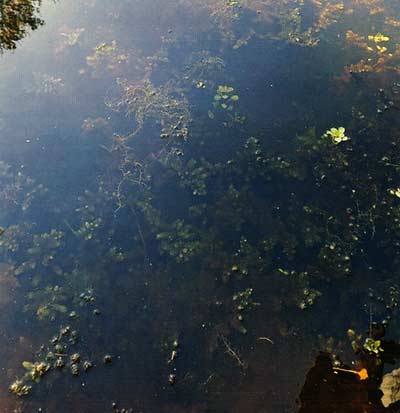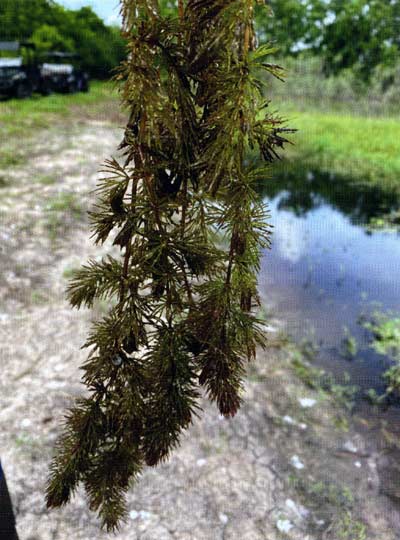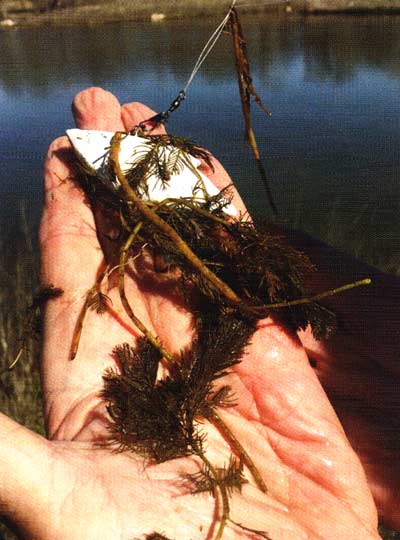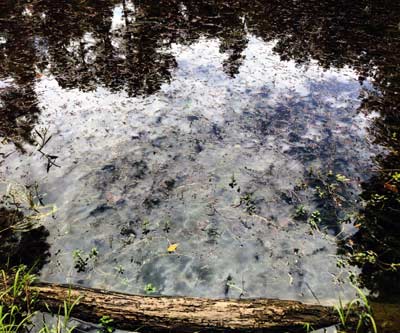
Over the years, aquatic plants are mostly given just some cursory touches on these pages. You know, how to figure out the best way to identify plants, maybe some tips on deciding if you like those plants. We discussed the basics, like driving lessons when we were teenagers.
There's the brake pedal, the accelerator pedal, starter, gear shift... drive, stop at red lights. Look both ways.
How about we take a deeper journey into aquatic plants? Maybe complicate the issue a tad bit?
We've covered the basics and spun the topic around. You've read it many times, "There are three basic categories: floating, submersed, and emerged-type plants." And, "Plants need the 'Big Three'...food, sunlight, and their temperature window for growth". Plus, "Plants photosynthesize during daylight hours and respire at night."
You get that.
There are three fundamental treatment pursuits—Physical, Biological, and Chemical. You pick based on the plant and your goals. You know that.
Should you introduce plants somewhere? If so, what?

At some risk, let's get a little lofty, maybe go up a few thousand feet and become a tad philosophical.
Let's do an exercise right now. If you have Google Earth, go to it. Pinpoint your pond. Zoom in. Then, look in the lower right-hand corner of that map and find "eye alt." That's how high off the ground you are looking. Look at your pond and the surrounding terrain at 4,000 feet, then go up to 10,000 feet, then 5 miles. You'll see what's immediately around your place, then what's within several miles...and so on. You'll see patterns of vegetation and how the local watershed looks. You'll see different plant ecosystems and environments, some influenced by landowners, others left to their own devices and opportunities. Different ecosystems influence local plant life. You'll see pastures, riparian areas, upland forests, grasslands, and crops.
Evaluate those surroundings compared to your place. As you understand what you see at those higher elevations, you can enhance your understanding of your property, the plants in and around your pond, and how they interact.
When you look closely at healthy ponds and lakes, you'll also see patterns there. I spoke with Brittany Chesser, Aquatic Plant Specialist at Texas A&M. When she approaches a pond, she first looks for the "Value of plants." She said, "I look at filter strips and buffer zones around the pond. What kinds of plants are there to filter incoming water? I look at the upper reaches of a pond to see how that watershed influences the pond with its variety and density of plants."
Density.
That's significant as you evaluate your aquatic plant life. Are the cattails so thick that they serve nesting redwing blackbirds more than your pond? What about rushes and reeds? Are they holding loose soils and not so dense as to inhibit the movement of important wildlife?

Brittany continued, "When I look at aquatic plants, I first evaluate density. How thick are those plants?" Look at, say, three square feet. Are the plants so dense that the greenery inhibits predators from eating their prey? Or is the density so loose that the prey doesn't stand a chance?
She continued, "After looking at plants as filters, I look for 'tapering.' Thorough density is common near shore, but as the water deepens, I expect the plants to taper off."
As biologists, we strive for "balance." That just doesn't seem to happen, especially with aquatic plant life. Nature ebbs and flows... sometimes more flow, sometimes more ebb. Plant growth is often not rhythmical.
Brittany had more to offer. "I look at the plant species and then evaluate what that plant mass has to offer." Does it attract fish? Maybe it's suitable for migrating waterfowl or local wading birds?
She looks for pockets of plants rather than seeing plants so dense that they are unsafe for people or inhibit a pond's ability to thrive.
As she evaluates, she looks at water clarity and compares that to plant life. "Micro¬organisms, such as plankton, are important to the ecology of most ponds. That influences the rooted plants. Rooted plants influence the pond."
"If plant mass covers more than 30% of a pond area, I think there's too much." By that, she means a patch of bushy pondweed, for example, shouldn't be so dense that it covers more than 30% of the pond bottom on any given day.
She mentioned coontail.
"Coontail can grow in the top of the water column deeper than five feet. It can certainly become invasive." When that happens, the pond suffers. Thick mats of coontail might be an excellent habitat for baby fish to hide and feed, and it might be temporarily good as an edge cover to catch bass, but as fast as that stuff grows when its window opens, it doesn't take long to get out of hand.
Some plants provide overlap for nutrition. Grazers may prefer one of your species over the others.
While we prefer species diversity, many ponds don't allow for that. We've all seen that pond...the one that only has Southern naiad...bushy pondweed. We don't necessarily want that to be the only plant, but that's a good thing as long as its density isn't ruthless and the mass doesn't overwhelm the pond and its inhabitants. So, we live with it.

As you evaluate your underwater salad bar, take off your rose-colored glasses, don a pair of polarized ones, grab a rake, and get to know your pond's offerings. We'll still tell you to identify each species and learn about that plant.
See how many different species you've got and understand another critical part of this pond management puzzle. Things will change. Plants will grow. The plants you see in late March won't be the same in late May. Those in late May will have different characteristics in mid-August. By then, you should have made management decisions and implemented those choices. If not, you may be staring down the barrel of a problem too late to fix. But some plants may thrive now, only to be overtaken in June by another opportunistic species you might like even better. But these plants may also grow so fast that your pond can become overwhelmed.
Dynamic, to say the least.
In biology, we learn never to say "never" or "always"...because "never" and "always" are always wrong. Remember that with your pond's aquatic plants.
That means you must be subjective.
Your pond is your pond. Native species of plants, in areas where they don't become invasive, are a good thing. Just keep in mind it's your choice. Your opinions matter. That means you have decisions.
So, now we circle back to all those basic tenets we've written about for over 30 years. Identify the plants and learn their life cycles. Monitor them as they grow. What happened last year with your pond's plants may differ this year. It might be better; it might be worse...subjectively speaking.
You'll see a different species from time to time.
If plants should be introduced, do it. If your plants need controlling, do it. If plants grow where they shouldn't, figure out what to do.
As you involve yourself with those polarized glasses and a rake, you'll soon see those driving lessons way back when you were a teenager only set the stage for you to make this aquatic plant journey with minimal wrecks because you'll soon see when to hit the brakes or stomp on the accelerator.
Just make your own map.
Reprinted with permission from Pond Boss Magazine



